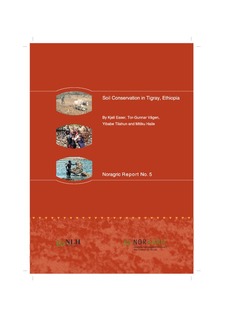| dc.description.abstract | Land degradation is a major cause of poverty in rural areas of developing countries. In many areas, farming populations have experienced a decline in real income due to demographic, economic, social, and environmental changes. Land degradation is a result of several factors of both physical and socio-economic nature. The immediate consequence of land degradation is reduced crop yield followed by economic decline and social stress. The integrated process of land degradation and increased poverty has been referred to as the "downhill spiral of unsustainability" leading to the "poverty trap" (Greenland et al., 1994).
Soil erosion is one facet of land degradation that affects the physical and chemical properties of soils. The physical parameters are primarily organic matter content, structure, texture, bulk density, infiltration rate, rooting depth, and water-holding capacity. Changes in chemical parameters are largely a function of changes in physical composition. The consequences of topsoil erosion on soil productivity depends on the depth and quality of the topsoil relative to the subsoil. In areas where the topsoil is acid and the organic matter content is initially low, surface erosion may, in fact, increase crop yields due to the exposure of a more favourable subsoil.
Tigray is the northern region of Ethiopia (Fig. 1). It consists of several agro-climatic zones, determined mainly by altitude, rainfall and temperature. The eastern parts of the region, including the Danakil depression, are extremely dry. The highlands of central Tigray vary in altitude from about 1 300 m to over 3 000 m in the highland areas of Adwa. Most parts of Degua Tembien and parts of Abergelle have rolling to hilly high plateaus. Most of the areas between 1 500 and 2 300 m have an annual rainfall of less than 900 mm. Rainfall in the area is unpredictable, and it is quite common to observe both water logging and drought during one cropping season. The population density in the region is relatively high, and small units of land are extensively cultivated by subsistence farmers.
The severity of soil erosion in the Tigray region and in Ethiopia in general, is the result of the mountainous and hilly topography, torrential rainfall, and low degree of vegetational cover. According to Hamilton (1977), deforestation started already 2 000 years ago. In many parts of Tigray, soil erosion has made cultivation of old farmland impossible. Farmers have been forced to constantly cultivate new and more marginal areas.
The objective of this presentation is to review soil erosion and conservation research as well as conservation efforts made in Tigray. We have included both traditional measures and activities promoted by non-government organizations (NGO's) and government projects. Main emphasis is placed on stone terracing and stone bunds since these are the most widely used soil conservation measures in the region. Relatively limited research has been made in Tigray. We have therefore included some important findings from other parts of the Ethiopian highlands for comparison. | nb_NO |

